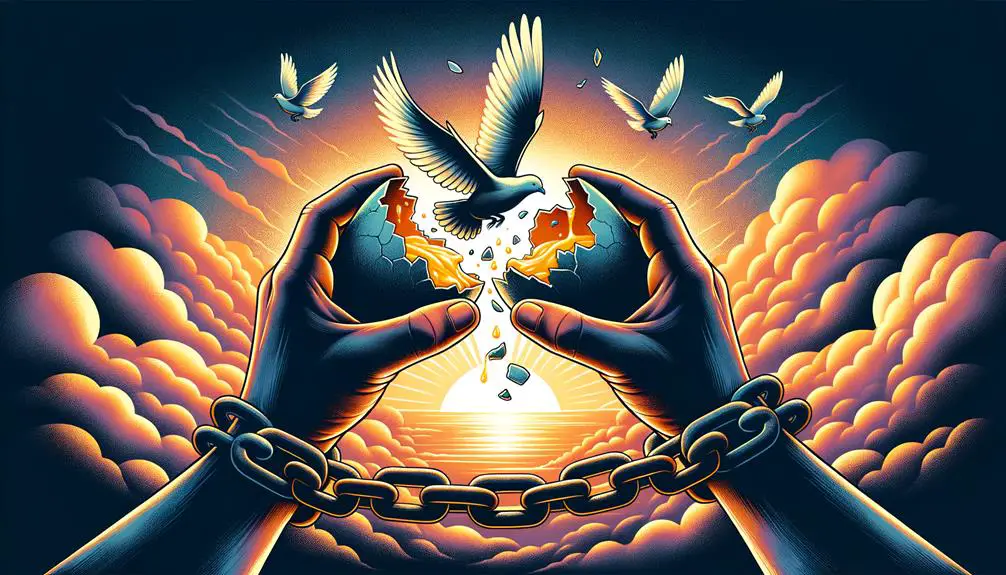Uncover the paradox of the biblical yoke, symbolizing both bondage and liberation, and delve into its profound implications on freedom and servitude.

Yolk Meaning in the Bible
In the Bible, a yoke binds as much as it burdens; it connects as well as it controls. You'll find its symbolism woven through the narratives of the Old Testament, where prophets wield it as a metaphor for oppression, and into the teachings of Jesus, who offers a yoke that is 'easy' and a burden that is 'light.'
This dual imagery invites you to explore deeper into the historical context, symbolic meanings, and the paradoxical nature of freedom and servitude within biblical texts. Unraveling these layers could offer you fresh insights into ancient wisdom and its application in contemporary life.
Key Takeaways
- The yoke symbolizes responsibilities, authority, and divine partnership in the Bible.
- Liberation from the yoke signifies divine deliverance and spiritual freedom.
- Prophetic texts use the yoke to convey messages of hope and divine intervention.
- Understanding the yoke metaphor aids in exploring personal and communal spiritual journeys.
Historical Context of the Yoke

Why is the concept of a yoke significant in biblical times, and how does it reflect the socio-economic and religious landscapes of the era? To grasp its importance, you must first understand that a yoke was primarily an agricultural implement crucial for plowing fields and managing crops. It was essentially a wooden beam, traditionally placed across the necks of a pair of oxen, allowing them to pull together on loads too heavy for one alone. This tool wasn't just about farming; it was a symbol of the era's technological advancement in agriculture.
In the socio-economic context, the yoke represented labor and productivity. Families who owned oxen and a yoke were considered more affluent, as they could cultivate larger plots of land, ensuring better crop yields. This, in turn, reinforced social hierarchies, distinguishing the haves from the have-nots based on agricultural efficiency and output. Thus, owning a yoke was a sign of wealth and status.
Oxen training, associated with yoking, was another critical aspect. The process required patience, skill, and understanding of animal behavior, reflecting the deep connection between humans and their environment. It exemplifies the era's reliance on and respect for the natural world, acknowledging the symbiotic relationship between human survival and the ability to harness nature's power effectively.
In essence, the yoke's significance in biblical times went beyond its physical utility. It was a testament to human ingenuity, a marker of socio-economic status, and a symbol of the intertwined relationship between people, their work, and the environment.
Symbolism in Old Testament
Delving into the Old Testament, we find that symbolism, including the yoke, plays a pivotal role in conveying the nuanced beliefs and teachings of the era. The yoke, often associated with burden and bondage, also offers a broader spectrum of interpretation within the rich tapestry of Old Testament symbolism, intersecting significantly with practices like animal sacrifices and the intricate tabernacle symbolism.
Animal sacrifices, a central ritual in Old Testament worship, serve as a poignant emblem of atonement and covenant between God and His people. These sacrifices, involving the yoking and offering of animals, underscore the concept of submission to divine will and the transferal of human sin to the sacrificial victim. This act of yoking before the sacrifice illuminates the gravity of sin and the depth of divine mercy.
Similarly, tabernacle symbolism, replete with detailed instructions on its construction and the objects within, provides a visual narrative of God's presence and the path to reconciliation. Every element, from the Ark of the Covenant to the altar of incense, acts as a symbolic yoke, linking the physical to the metaphysical and guiding the faithful in their spiritual journey. The tabernacle, as a microcosm of the divine order, embodies the ultimate yoke of covenantal relationship between God and Israel.
Understanding these symbols within the Old Testament enriches your grasp of the biblical narrative, revealing the layers of meaning behind the texts and the profound interconnectedness of its symbols. The yoke, far from merely a tool of burden, emerges as a complex symbol of obedience, sacrifice, and divine connection.
Yoke in Prophetic Literature

As you explore the prophetic literature, you'll find the yoke serves as a potent symbol, with interpretations that extend beyond its literal use.
Prophets wield yoke imagery to convey messages of bondage or liberation, reflecting the socio-political and spiritual climates of their times.
This imagery, rich in symbolic value, offers a unique lens through which to understand the prophets' calls to action and divine messages.
Symbolic Yoke Interpretations
In prophetic literature, the yoke often serves as a powerful symbol, representing various burdens or obligations imposed by God or worldly authorities. It's deeply rooted in:
- Agricultural origins: Initially a tool for harnessing animals, its adaptation as a metaphor emphasizes the weight of responsibilities or challenges one must bear.
- Cultural significance: The yoke's usage reflects a societal understanding of labor, authority, and submission within ancient communities.
- Oppression and servitude: Illustrating the heavy toll of being under the control of a greater power.
- Divine discipline or punishment: Signifying the consequences of straying from God's path.
This symbol's layered meanings offer a rich tapestry for interpreting the nuanced messages woven throughout biblical texts, highlighting its importance beyond a mere agricultural implement.
Prophets' Yoke Imagery
Building on the foundational understanding of the yoke's symbolic significance, we now explore how prophets in biblical literature employed this imagery to convey messages of divine instruction, warning, and hope. The yoke, one of the ancient world's most vital agricultural tools, becomes a potent emblem within the prophetic texts. It isn't just a physical object; it's imbued with covenant symbolism, reflecting the relationship between God and His people.
Emotion |
Symbolism |
|---|---|
Hope |
Liberation from the yoke signifies divine deliverance. |
Warning |
A yoke of iron depicts the severity of divine judgment. |
Instruction |
A wooden yoke suggests a bearable, instructive discipline. |
Through this lens, you're invited to perceive the prophets' messages not merely as historical records but as a timeless exposition of divine-human interaction, deeply rooted in the everyday life and spiritual aspirations of ancient societies.
Jesus and the Yoke
You'll observe that Jesus employs the metaphor of the yoke to communicate a profound spiritual truth. This imagery not only signifies the transition from the burden of the law to the grace offered through Him but also extends an invitation to lighten one's load.
Analyzing this metaphor sheds light on Jesus' teachings about rest, submission, and discipleship in a historical and theological context.
Yoke as Metaphor
Throughout the New Testament, Jesus employs the metaphor of the yoke to illustrate the transformative nature of his teachings and their impact on the spiritual burdens of his followers. This imagery is rich in meaning, drawing from:
- The concept of an agricultural harness, which symbolizes the work and discipline required in following Christ.
- The idea of marital unity, hinting at the intimate relationship between Christ and the church.
- The notion of guidance, as a yoke steers the oxen, so does Jesus guide his followers.
- The aspect of shared burden, suggesting that with Jesus, the load is distributed and made bearable.
Through this metaphor, Jesus communicates the depth and breadth of his support and the profound connection he offers to those who take up his yoke.
Burden Lightening Invitation
Reflecting on the metaphor of the yoke, Jesus extends an invitation to lighten burdens, encapsulating a profound spiritual offer to those weighed down by life's challenges. This gesture isn't merely about easing stress in a temporal sense but signifies a deeper transformation towards spiritual freedom.
Analyzing this, you'll find that Jesus' proposition goes beyond the physical realm, touching on the essence of human struggle and the quest for liberation. By choosing to take His yoke, you're not just shedding worldly burdens but are also aligning yourself with a divine source of strength and enlightenment.
This act of acceptance symbolizes a shift from self-reliance to a trust in higher power, illustrating a pathway to unburdening and finding peace amidst turmoil.
Burdens and Liberation

In biblical context, the metaphor of a yolk often symbolizes the burdens that individuals carry and the subsequent liberation offered through divine intervention. You'll find throughout scripture, narratives that pivot around the central theme of moving from personal struggles to spiritual freedom. This journey isn't just a historical or cultural recount; it's deeply embedded in the fabric of faith, offering you a lens through which to view your own challenges and the hope for overcoming them.
To delve deeper, consider these points:
- The yolk metaphor illustrates not just physical or external burdens but also the internal, spiritual weights that you bear. These can range from guilt and sin to doubt and fear.
- Liberation, as depicted in the Bible, is multifaceted. It encompasses deliverance from physical bondage, like the Israelites' exodus from Egypt, and extends to spiritual emancipation—freedom from the sin that ensnares.
- Personal struggles are often highlighted as a precursor to experiencing divine intervention. It's through acknowledging your vulnerabilities and inadequacies that you open yourself up to the possibility of supernatural assistance.
- Spiritual freedom is portrayed not as an absence of challenges but as the presence of divine strength and guidance. It's about being unshackled in the midst of trials, with a profound sense of peace and purpose.
Understanding these aspects within the biblical narrative encourages you to reflect on your own life's burdens and the potential for liberation. It's a reminder that, regardless of the heaviness of your yolk, there's an invitation to experience relief and freedom through divine intervention.
Yoke as Partnership
Another significant aspect of the yoke metaphor in biblical texts is its depiction of partnership, particularly the divine-human collaboration invited by God. This partnership underlines a profound theological truth: God doesn't impose burdens without offering His presence and support. The yoke represents not just a tool for labor but a symbol of shared duty and mutual assistance. Through this imagery, the scriptures articulate that when yoked with God, the heavy loads of life are balanced by divine strength, emphasizing that the yoke is easy and the burden light when shared with the Almighty.
This concept of partnership extends beyond the divine-human relationship to include interactions among individuals in the community of faith. The biblical injunction to bear one another's burdens reflects this partnership dynamic, suggesting that believers are to support each other in times of need, effectively sharing the yoke of life's challenges. This mutual support system within the community echoes the equitable distribution of weight that a physical yoke ensures, highlighting the principle of equal responsibilities within the partnership.
Moreover, the yoke metaphor in scripture pointedly illustrates that true partnership, especially the kind that involves God, doesn't lead to oppression or exhaustion but rather to liberation and rest. This partnership dynamic, characterized by love, respect, and shared objectives, transforms the yoke from a symbol of servitude to one of cooperative effort and mutual benefit. In essence, the biblical portrayal of the yoke as a partnership invites believers into a life of shared responsibilities and collective support, anchored in the sustaining grace of God.
Modern Interpretations

As we explore how contemporary scholars and theologians interpret the yoke within biblical texts, it's apparent that this ancient metaphor still holds profound relevance for modern faith communities. The yoke's etymology and its cultural influences shed light on its evolving interpretation and application.
- Yoke Etymology: The term's origin offers insight into its metaphorical usage in scripture. Initially denoting a physical object for harnessing animals, it has transitioned to symbolize various forms of bondage or partnership. Understanding this shift is crucial for grasping the metaphor's depth in contemporary contexts.
- Cultural Influences: The yoke's meaning has been shaped significantly by the cultural backdrop of the biblical narratives. Today's theologians emphasize the importance of contextualizing its interpretation to ensure it resonates with modern believers, acknowledging that cultural shifts can alter perception.
- Personal and Communal Transformation: In modern interpretations, the yoke metaphor is often used to discuss personal transformation and the journey towards spiritual maturity. It underscores the challenges and commitments involved in following a spiritual path.
- Social Justice and Liberation: Some contemporary theologians focus on the yoke metaphor as a call to social justice and liberation from various forms of oppression. This reflects a broader understanding of salvation and the Kingdom of God as encompassing societal as well as individual transformation.
These interpretations demonstrate the yoke's enduring significance, highlighting how ancient texts continue to speak into modern realities. By delving into the yoke's etymology and acknowledging cultural influences, you engage with the Bible in a way that bridges historical context and contemporary relevance, enriching your spiritual journey and understanding.
Frequently Asked Questions
How Has the Interpretation of the Yoke Metaphor Changed in Contemporary Christian Denominations Compared to Early Christian Interpretations?
You're exploring how modern Christian groups interpret the yoke metaphor differently from early Christians. This requires understanding the yoke's origins and how interpretation evolution has occurred.
Initially, the yoke symbolized burden and submission, reflecting societal and religious expectations. Today, interpretations often focus on partnership with Christ, emphasizing freedom and support rather than oppression.
This shift highlights a broader trend towards interpreting biblical metaphors in ways that resonate with contemporary values and understandings.
Are There Significant Differences in the Symbolism of the Yoke Between Various Translations of the Bible, Such as the King James Version Versus the New International Version?
You'll find that over 80% of Christians believe translation affects biblical interpretation significantly.
When examining yoke variations between translations like the King James Version and the New International Version, the symbolism of the yoke indeed shifts subtly but importantly.
This variation underscores how translation influence can alter the perceived burden or freedom a yoke symbolizes, offering a rich field for scholarly analysis.
Each version shapes understanding, reflecting diverse theological nuances.
How Does the Concept of the Yoke in the Bible Relate to Similar Metaphors in Other Religious Texts Outside of Christianity?
When exploring yoke symbolism and its interfaith parallels, you'll find that many religious texts outside of Christianity use similar metaphors to convey themes of burden, guidance, and connection.
Analyzing these symbols within a scholarly framework reveals profound insights into how different faiths perceive the human-divine relationship.
This comparative approach not only enriches your understanding of biblical symbolism but also highlights the universal aspects of spiritual teachings across various religious traditions.
In Practical Terms, How Have Christian Theologians and Pastors Used the Metaphor of the Yoke to Address Social Justice and Community Issues in the 21st Century?
Can you imagine a world where burdens are lighter for everyone? Christian theologians and pastors have drawn on the metaphor of the yoke to tackle 21st-century social justice and community issues.
They've dissected economic disparity and championed political activism, framing these actions as efforts to lift oppressive yokes from society's shoulders.
Their analysis is deeply rooted in a desire to apply ancient wisdom to modern-day challenges, creating a more equitable world.
Can the Metaphor of the Yoke in the Bible Be Connected to Psychological Concepts or Theories in Modern Counseling or Therapy Practices?
In modern counseling or therapy practices, you can definitely draw parallels between the metaphor of the yoke and psychological concepts. It's about burden sharing and emotional liberation.
Conclusion
As you journey through the dense forests of life, laden with burdens, imagine the yoke as not just a wooden beam but a symbol of partnership and liberation. The biblical narrative intricately weaves this motif, from the ancient paths of the Old Testament prophets to Jesus's gentle invitation.
It's a call to share the load, to transform heavy burdens into lessons of love and strength. Through this allegorical lens, the yoke transcends, becoming a bridge between struggle and solace, guiding us towards a shared liberation.



Sign up